APRIL IS ONE OF THE MOST EXCITING TIMES in the New England Apple orchard. It is also the most nerve-racking.
The excitement comes from the gradual unfurling of the blossoms that will eventually become the year’s apple crop.
The anxiety is over the threat of a hard frost. Apple blossoms can withstand temperatures to about 28ºF. A freeze much lower will kill the buds before they can bear fruit. The risk may continue as late as Memorial Day in some northern locations.
For several weeks now, the buds have advanced from silver to green tip (see below for a description of the stages). Next comes tight cluster, then open cluster, and finally match tip, or pink, just before the buds swell and the flowers burst open.
Most of the trees in New England orchards are between green tip and tight cluster by now, with match tip another week or so away, depending on weather and location.
Typically, spring bloom occurs in early May, peaking around Mother’s Day in much of New England, after the pale pink peach blossoms have already come and gone. (Peaches are even more vulnerable to frost than apples due to their earlier blooming time.)
Growers use different strategies to try to mitigate the dangers of frost, though the size of commercial orchards makes it difficult at best. Some place windmills in the orchard to keep air circulating and the cold from settling in.
Others warm the trees from beneath with smudge pots, but this can only be done on a small scale. Some try coating the buds with sprinklers, preserving them inside a 32ºF ice cocoon.
Some growers maintain orchards in multiple locations to spread out the risk, from not just frost but later-season threats like hail. With luck, in the face of a weather disaster they may not lose their entire crop.
Early heat waves can increase the frost period by forcing the buds to open prematurely, lengthening the time they are vulnerable. Fortunately, that has not been the case this spring; bloom is on schedule.
Now it is a question of getting through these next few weeks without incident until New England orchards are teeming with millions of lightly scented blossoms. It is a brilliant sight.
* * *
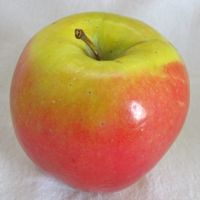
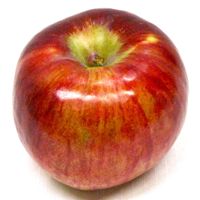
Cortland apple. (Bar Lois Weeks)
GOOD NEWS for consumers is that they don’t have to wait until summer to bite into a crisp New England apple!
There are still many locally grown apples fresh from controlled-atmosphere (CA) storage available in supermarkets and a number of orchard stores, as well as excellent fresh and hard ciders. Visit our Orchard Finder to see who remains open.
CA storage accounts for the crispness. Apples are loaded into sealed, insulated CA rooms immediately after harvest. Most of the oxygen is then removed from the rooms, and temperature, humidity, nitrogen, and carbon dioxide are carefully monitored to bring the apples’ respiration to a virtual standstill until the room is opened months later.
Whether at home or in the grocery store, apples should be kept cold to retain crispness. But if stored properly, even softer-fleshed apples like McIntosh remain crisp throughout the year.

Use Ambrosia, Cortland, McIntosh, EverCrisp or other New England-grown variety in this recipe for Apple Squash Casserole, sent to us by Nancy Spinney of Southport, Maine. Its rich, sweet flavor pairs wonderfully with haddock or any bland white fish.
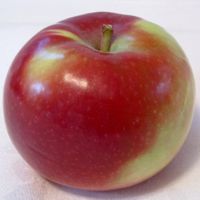
APPLE SQUASH CASSEROLE
4 c butternut squash, cubed
2 large New England apples
1/4 c brown sugar
1 T flour
1/4 c cold butter
1/4 t nutmeg
1/4 t cinnamon
1 t salt
Preheat oven to 350ºF.
Core and slice apples. Combine with bite-size cubes of squash in a 7×11 baking pan.
Using a pastry blender, mix butter, brown sugar, flour, and spices until crumbly. Sprinkle over the squash and apples.
Cover and bake for 45 to 50 minutes, until squash is tender and topping is brown.
“I often add a handful of chopped walnuts,” writes Nancy, “or add cubed sweet potato to the squash and apples, or both.”
She usually uses a deeper baking dish “and I fill it by adding more squash and a couple of extra apples,” and the same amount of crumb topping. The deeper dish requires a longer a baking time, she says, as much as 90 minutes, depending on the size and amount of the squash.
* * *
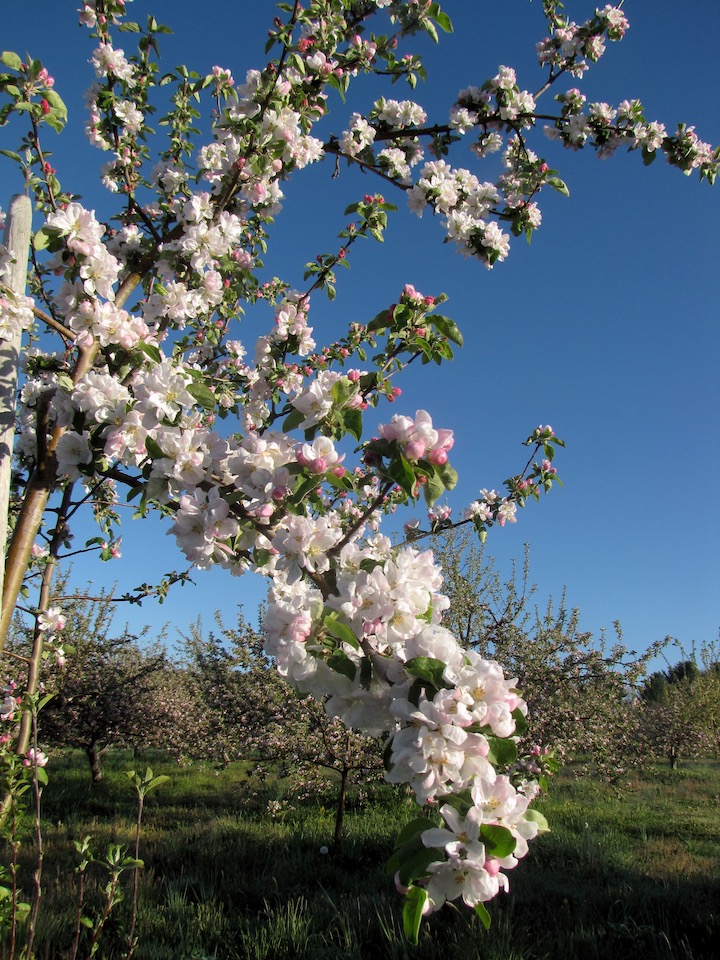
THE STAGES OF APPLE BLOOM:
As apple trees emerge from winter dormancy, the silver tip stage begins. The bud’s brown outer scales slowly separate, exposing light gray or silver tissue at the tip.
Green tip follows silver tip, revealing a sliver of green tissue, gradually growing to half-inch green.
In tight cluster, buds are tightly grouped and have short stems. By match tip, or pink, stage, the buds are a deep color, with longer stems. They begin to spread apart into open cluster.
King bloom is when the first blossom in each cluster opens. At full bloom, most or all buds are open.
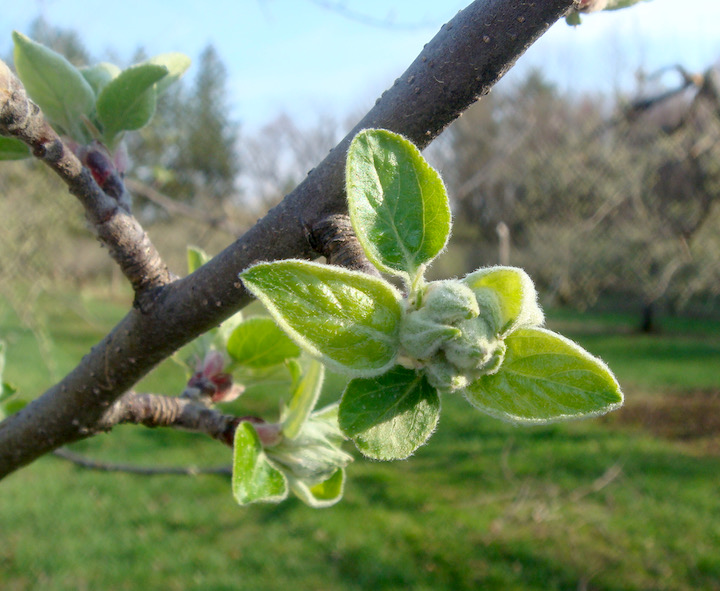
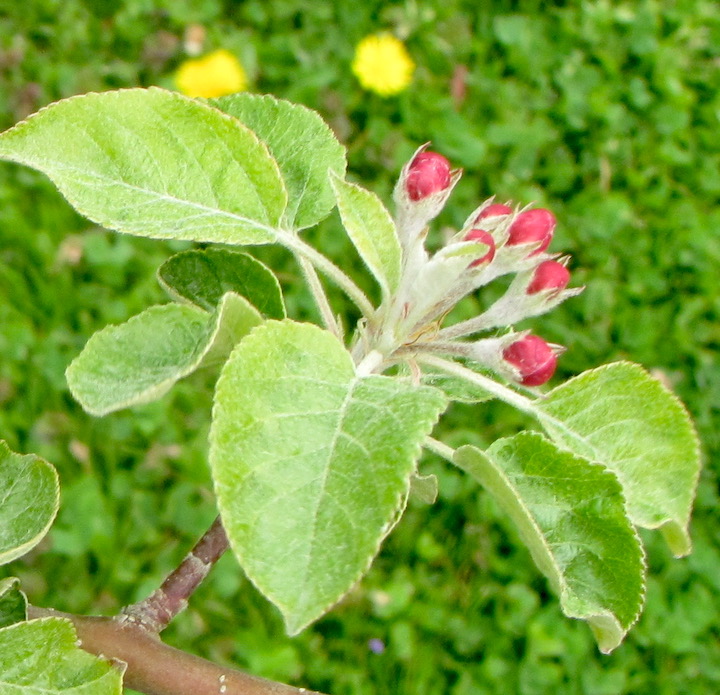
8 Comments
Steve Lacasse
Russell, Once again I enjoyed your latest post. You truly understand the needs of the apple industry in New England and I am grateful that you still represent them as a spokesperson, published author and benefactor. You have what is needed figured out.
Russell Powell
Thank you, Steve. That means a lot coming from you, with your many years of experience and knowledge of the apple trade. I came across a photo of you a few nights ago, btw, and it triggered pleasant memories. I hope you are well, and that our paths cross again soon. Thanks again for the kind words. Much appreciated.
ROBERT H. BOOTHBY
That is a nice news letter and very interesting for growers. This is what we are all thinking about.
Russell Powell
Thank you so much, Rob! Here’s hoping for warm–but not too warm!–weather.
Larry Dean
The mention of the early silver stage of the apple blossom inevitably made me think of Robert Frost’s short poem “Nothing Gold Can Stay.”
Nature’s first green is gold,
Her hardest hue to hold.
Her early leaf’s a flower;
But only so an hour.
Then leaf subsides to leaf.
So Eden sank to grief,
So dawn goes down to day.
Nothing gold can stay.
Russell Powell
Beautiful! Thanks for sharing.
Jan
So beautifully put together Russ! As always you inspire me to see!!!! Thank you my friend!!!! Your photography is gorgeous and so clear!
Russell Powell
Many thanks, Jan! Apples and orchards continue to inspire after all these years.